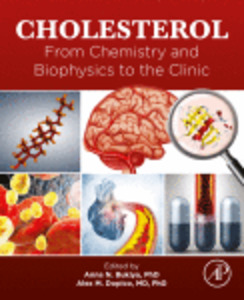Por favor, use este identificador para citar o enlazar este ítem:
https://repositorio.uca.edu.ar/handle/123456789/14434| Título: | Fluorescent probes for microscopy visualization of cholesterol topography and dynamics in membranes | Autor: | Barrantes, Francisco José | Palabras clave: | FLUORESCENCIA; COLESTEROL; MEMBRANAS CELULARES; LIPIDOS | Fecha de publicación: | 2022 | Editorial: | Academic Press | Cita: | Barrante, F.J. Fluorescent probes for microscopy visualization of cholesterol topography and dynamics in membranes [en línea]. En: Bukiya, A.N., Dopico, A.M. (eds.). Cholesterol. From Chemistry and Biophysics to the Clinic. Londres: Academic Press, 2022 doi:10.1016/B978-0-323-85857-1.00015-8 Disponible en: | Resumen: | Abstract: In attempting to interrogate the structural and functional properties of cell membranes with minimal invasiveness, fluorescence microscopy remains the gold-standard technique. Fluorescence is a highly versatile spectroscopic property covering a wide range of the spectrum, with inherent advantages in both the spatial and time domains. Fluorescent probes have been key elements in the constellation of tools used to push the limits of spatial resolution down to single-molecule localization, optimize visualization of delicate biological structures in the living cell, and enable the tracking of molecular motions with high temporal precision. Cholesterol is an essential component of eukaryotic membranes; it interacts with other lipids and proteins and has a modulatory function on many membrane-resident hormone and neurotransmitter receptors. Fluorescent sensors have played an important role in revealing different biological and physicochemical properties of cholesterol. In cell biology applications, fluorescent cholesterol sensors helped determine uptake mechanisms and topography in the plasma membrane and follow the intracellular trafficking of cholesterol. Biophysical investigations have resorted to fluorescent probes to establish orientation, rotational, and translational motions in the membrane, order/disorder, and physical changes brought about by the presence of the sterol in the phospholipid bilayer. The ample spectral range and varying specificities of direct and indirect probes designed to visualize cholesterol enable the experimentalist to study a wide array of cholesterol properties and/or learn about the influence of the sterol on other lipids, membrane proteins, and transient supramolecular assemblies like membrane-resident lipid domains. | URI: | https://repositorio.uca.edu.ar/handle/123456789/14434 | ISBN: | 978-0-323-85857-1 | Disciplina: | MEDICINA | DOI: | 10.1016/B978-0-323-85857-1.00015-8 | Derechos: | info:eu-repo/semantics/closedAccess | Fuente: | Bukiya, A.N., Dopico, A.M. (eds.). Cholesterol. From Chemistry and Biophysics to the Clinic. Londres: Academic Press, 2022 doi:10.1016/B978-0-323-85857-1.00015-8 |
| Aparece en las colecciones: | Libros o partes de libro |
Ficheros en este ítem:
| Fichero | Descripción | Tamaño | Formato | Login |
|---|---|---|---|---|
| fluorescent-probes-microscopy.pdf | 31,79 MB | Adobe PDF | SOLICITAR ACCESO | |
| thumb.gif | 13,2 kB | GIF |  Visualizar/Abrir |
Visualizaciones de página(s)
80
comprobado en 27-abr-2024
Descarga(s)
32
comprobado en 27-abr-2024
Google ScholarTM
Ver en Google Scholar
Altmetric
Altmetric
Este ítem está sujeto a una Licencia Creative Commons

